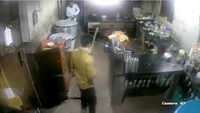
A group of elderly men forms a huddle and smokes hookah from the same pipe
People jostle for ration in a queue outside a grocery store that has just opened
Young boys zoom past in bikes on a colony road — some wearing masks, others just covering their faces with hands
At a time the city accounts for almost half of Haryana’s Covid cases, scenes like these are a common sight at containment zones, whose purpose is to restrict movement to contain the spread of Covid-19.
Projections released last week have thrown up alarming numbers. Mthematical models based on the current doubling rate have projected that Covid cases in Gurgaon can reach 1.5 lakh by July 31 and 2.5 lakh by the end of August. The government has emphasised a strict containment strategy, along with social distacing and wearing masks, as key to arresting the spread of the virus.
Although Gurgaon has been increasing the number of containment zones with the rise in Covid cases — 94 as of now — caution has been thrown to the wind in many of these places.
A visit to some of the sealed areas revealed there are hardly any policemen to regulate the movement of residents or visits by health workers to make people aware about the importance of following Covid protocols.
In Dundahera, for instance, the entry and exit points were highly porous and bamboo barricades erected here barely served any purpose. Most shops were open and people lined up outside just like any ordinary day. A cop on duty sat under the shade of a tress, his mask barely covering his nose. “There is no proper containment strategy here. We have just restricted the entry of vehicles. Even if we ask the residents to wear masks or not to gather around, they do not listen to us. What will I do alone?” he asked.
A few kilometres away in DLF-2, the situation was hardly different. The gates of this upscale neighbourhood did not even have a barrier or a cop. Residents moved freely in bikes and cars. Guards at one of the societies said a police team had been patrolling till last week, but they were nowhere to be seen since. “Police outposts were there outside entry and exit points. But now, cops can only be found outside the house of patients. Patrolling vans come occasionally,” said Ranbir, a guard.
Residents agreed with him, calling for a more scientific approach towards identification of contacts and surveillance of those in quarantine. “ I think we need to install thermal scanners and thermometers at entry gates for better results,” said actor Mukesh Tyagi, a resident of L block in DLF-2.
Urban villages such as Sarhaul, Dundahera and Chakkarpur, which have a high population density with residents packed together in small clusters of houses, require a stricter implementation of containment rules. But things seemed no better in these areas either.
In Chakkarpur, an official at the sub-primary health centre admitted that containment efforts were largely only on paper. “The containment strategy was being implemented in the initial days. Since norms were relaxed elsewhere, people became lax in their attitude,” he added.
Chakkarpur appeared to be bustling with activity. “The government can be issuing guidelines. But if people don’t follow them, nothing can be done. Elderly people can be seen forming groups and smoking hookah. When we tell them not to sit so close to each other, they say none of them has any symptoms,” said Ashok Kumar, a senior citizen. Here, too, policemen have been “occasional” in their visits.
Police sources said that with the current strength, it was practically impossible to man all 100 containment zones. According to rules, each containment zone should have at least 35 policemen outside it. At 100 containment zones in the district, 3,500 cops would be required to just be on Covid duty. The sources said the 6,100-strong district police force could not afford to spare so many cops for this purpose alone.
Moreover, many cops deployed in containment zones earlier have tested positive. This has triggered anxiety among others in the force, and more and more cops are citing health reasons to ask for duty in other areas.
Similar is the situation for Asha workers, who are engaged in collecting information about Covid contacts and help the administration in surveillance. Sources said surveillance had taken a hit recently because many Asha workers had been demotivated over complaints of low wages and substandard masks, gloves and PPE kits.
Gurgaon has a total of 1,030 Asha workers, all of whom have been on Covid duty since March. Nine of them have already tested positive.
“We have been in the frontline along with doctors from the very beginning. We go to receive patients, put them in ambulances, take care of the ones in home isolation and carry out surveys. Despite all this, we are being paid only Rs 1,000 a month. We don’t even have good quality PPE kits, gloves or masks,” said Meera Devi, an Asha worker facilitator from Pataudi.
Deputy commissioner Amit Khatri said hotspots would be reviewed every 2-3 days.
People jostle for ration in a queue outside a grocery store that has just opened
Young boys zoom past in bikes on a colony road — some wearing masks, others just covering their faces with hands
At a time the city accounts for almost half of Haryana’s Covid cases, scenes like these are a common sight at containment zones, whose purpose is to restrict movement to contain the spread of Covid-19.
Projections released last week have thrown up alarming numbers. Mthematical models based on the current doubling rate have projected that Covid cases in Gurgaon can reach 1.5 lakh by July 31 and 2.5 lakh by the end of August. The government has emphasised a strict containment strategy, along with social distacing and wearing masks, as key to arresting the spread of the virus.
Although Gurgaon has been increasing the number of containment zones with the rise in Covid cases — 94 as of now — caution has been thrown to the wind in many of these places.
A visit to some of the sealed areas revealed there are hardly any policemen to regulate the movement of residents or visits by health workers to make people aware about the importance of following Covid protocols.
In Dundahera, for instance, the entry and exit points were highly porous and bamboo barricades erected here barely served any purpose. Most shops were open and people lined up outside just like any ordinary day. A cop on duty sat under the shade of a tress, his mask barely covering his nose. “There is no proper containment strategy here. We have just restricted the entry of vehicles. Even if we ask the residents to wear masks or not to gather around, they do not listen to us. What will I do alone?” he asked.
A few kilometres away in DLF-2, the situation was hardly different. The gates of this upscale neighbourhood did not even have a barrier or a cop. Residents moved freely in bikes and cars. Guards at one of the societies said a police team had been patrolling till last week, but they were nowhere to be seen since. “Police outposts were there outside entry and exit points. But now, cops can only be found outside the house of patients. Patrolling vans come occasionally,” said Ranbir, a guard.
Residents agreed with him, calling for a more scientific approach towards identification of contacts and surveillance of those in quarantine. “ I think we need to install thermal scanners and thermometers at entry gates for better results,” said actor Mukesh Tyagi, a resident of L block in DLF-2.
Urban villages such as Sarhaul, Dundahera and Chakkarpur, which have a high population density with residents packed together in small clusters of houses, require a stricter implementation of containment rules. But things seemed no better in these areas either.
In Chakkarpur, an official at the sub-primary health centre admitted that containment efforts were largely only on paper. “The containment strategy was being implemented in the initial days. Since norms were relaxed elsewhere, people became lax in their attitude,” he added.
Chakkarpur appeared to be bustling with activity. “The government can be issuing guidelines. But if people don’t follow them, nothing can be done. Elderly people can be seen forming groups and smoking hookah. When we tell them not to sit so close to each other, they say none of them has any symptoms,” said Ashok Kumar, a senior citizen. Here, too, policemen have been “occasional” in their visits.
Police sources said that with the current strength, it was practically impossible to man all 100 containment zones. According to rules, each containment zone should have at least 35 policemen outside it. At 100 containment zones in the district, 3,500 cops would be required to just be on Covid duty. The sources said the 6,100-strong district police force could not afford to spare so many cops for this purpose alone.
Moreover, many cops deployed in containment zones earlier have tested positive. This has triggered anxiety among others in the force, and more and more cops are citing health reasons to ask for duty in other areas.
Similar is the situation for Asha workers, who are engaged in collecting information about Covid contacts and help the administration in surveillance. Sources said surveillance had taken a hit recently because many Asha workers had been demotivated over complaints of low wages and substandard masks, gloves and PPE kits.
Gurgaon has a total of 1,030 Asha workers, all of whom have been on Covid duty since March. Nine of them have already tested positive.
“We have been in the frontline along with doctors from the very beginning. We go to receive patients, put them in ambulances, take care of the ones in home isolation and carry out surveys. Despite all this, we are being paid only Rs 1,000 a month. We don’t even have good quality PPE kits, gloves or masks,” said Meera Devi, an Asha worker facilitator from Pataudi.
Deputy commissioner Amit Khatri said hotspots would be reviewed every 2-3 days.
Quick Links
Kerala Coronavirus Helpline NumberHaryana Coronavirus Helpline NumberUP Coronavirus Helpline NumberBareilly NewsBhopal NewsCoronavirus in DelhiCoronavirus in HyderabadCoronavirus in IndiaCoronavirus symptomsCoronavirusRajasthan Coronavirus Helpline NumberAditya ThackerayShiv SenaFire in MumbaiAP Coronavirus Helpline NumberArvind KejriwalJammu Kashmir Coronavirus Helpline NumberSrinagar encounter
Get the app








